We decided to run this test to see how Sony FS7 (the new large sensor camera now shipping worldwide) performs in comparison with Canon C300 (professionals’ workhorse and real benchmark for this kind of devices) and Sony Alpha 7S (from now on A7S), a full frame mirrorless camera that is very well known and appreciated for its low light still and video recording capabilities.
The Sony FS7 was provided by Gianni Gaudenzi, a freelance video maker (www.lunavideo.it), Canon C300 is owned by Roberto Cimatti, AIC Italian cinematographer, (www.robertocimatti.it) while Sony A7S belongs to the author of this article (www.keyframe.tv).
Why these cameras?
Sony FS7 is the “new kid on the blog” and everybody is talking and writing about it all over the internet. So far we have seen a decent amount of footage shot who this camera but nothing really eye-catching or particularly convincing (Sony didn’t impress with its initial footage of Japanese craftwork). Moreover footage shot by early customers shows part of this camera’s capabilities but doesn’t seem to emphasize its strengths and weaknesses that all customers should be aware of before choosing to purchase a 7,999$ camera.
Canon C300 is very popular among professionals and has shown to deliver in a very wide range of situations. It’s ergonomically very well thought and its color science has set new standards in the indie cinema and broadcast business. As a brilliant cinematographer and a much appreciated docu-style shooter Roberto is very pleased with the footage quality and speed of execution.
Sony A7S is a very versatile mirrorless camera whose ability so see in the dark make it the perfect companion for night scenes and low light sets. It features a wide dynamic range (officially above 14 stops) a full frame sensor, a strong and reliable codec (a .mp4 wrapped XAVC-S – derived from the acclaimed professional Sony XAVC legacy codecs), Sony Slog2 to and the ability to output a 4K signal to send to and external recorder.
After using the camera for a couple of months now, I find it very performing but making the best out of it can get a little tricky at times. It’s Log Preset (Sony SLog2) is very effective but dealing with a native ISO of 3200 and a very peculiar highlights and shadows handling requires attention and knowledge. Fortunately it’s 2014 and we can rely on acclaimed professionals and web-stars like Alister Chapman who devotes part of his time finding and sharing much useful information about Sony cameras and accessories hence I invite you all to read this incredibly interesting article (http://www.xdcam-user.com/2014/08/exposing-and-using-slog2-on-the-sony-a7s-part-one-gamma-and-exposure/) if you haven’t done it already.
Exposure reading at ISO 800
The set
As freelance videographers we don’t have free access to movie-TV facilities or similar therefore we decided to run these tests at Gianni’s post production studio. Definitely not a huge room but dark and cozy enough to manage a small and fast lighting setup. After a brief consultation, Roberto decided to deal with “dangerous” light, mixing different color temperatures and emphasizing contrasts and dynamic range to see how these three camera can perform in a very troublesome situation (something every pro ends up coping with sooner or later). Model is Silvia Bravi.
We didn’t take pictures of the set but you can find a very detailed exposure wise explanation of the shot below.
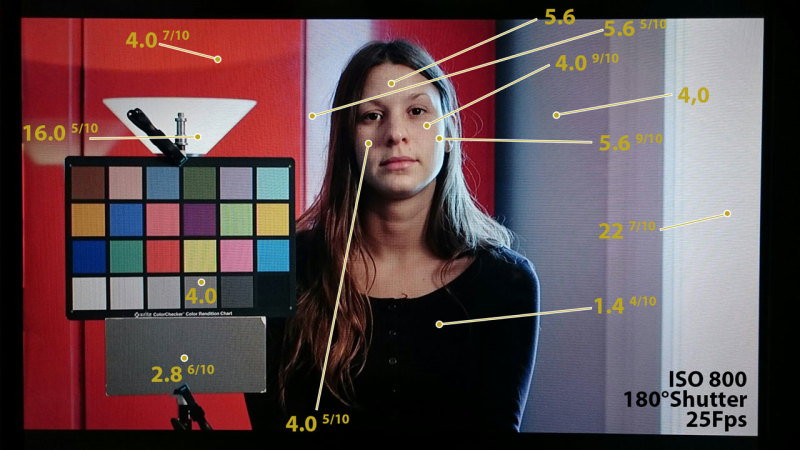
As you can see the range from dark areas to highlights is pretty wide so we could see how each camera deals with shadows and clipping. Even colors and lights were arranged to get as much information as possibile about saturation and color shift management.
We also used an X-Rite color chart for color match post-production process and a 18% grey card for helping us determining the right exposure.
All 3 cameras were mounted on a Vinten Vision 3 tripod and by adjusting the run of the sliding plate we shot all the footage keeping the same distance from the focal plane to the subject. As for the A7S we used the APS-C option that allowed us to have the same field of view of a super 35mm camera on the full frame Sony A7S.
We used the 50mm Canon CN.E lens that we mounted on the two Sony cameras via the Metabones NEX-EF Mark IV adapter. As you will see, Sony FS7 has a slightly narrower field of view than Canon C300 and Sony A7S in APS-C mode, because the active area of the sensor is proportionately narrower than the other cameras (thanks Steve Jones).
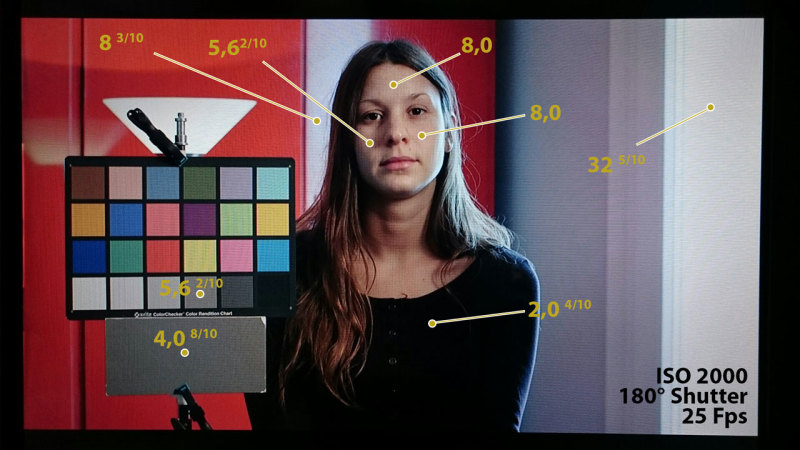
The process
For each camera we decided to shoot at normal exposure (as measured by Sekonic L-778 Dual Spot Exposure Meter) then 3 stops over and 3 stops under the spot meter reading.
We decided to design this procedure despite all the findings and white papers about Slog3 and Slog 2 handling, just as if we were some unaware users or orthodox d.o.ps. that follow the conservative method (setting the ISO, Fps and shutter in the spot meter then reading the values).
Here you can see the same setup with exposure readings set at 2000 ISO (for matching Sony FS7 native sensitivity).
All the footage was recorded internally taking advantage of the best recording option each camera has to offer.
Canon C300 uses a mpeg2 50Mbit 4:2:2 codec wrapped in a .mxf file. With Sony A7S we chose the XAVC-S 50Mbit 4:2:0 option (wrapped in .mp4 file) while for Sony FS7 we decided to record the footage using the new XAVC-I 100Mbit 4:2:2 codec.
Although we added another variable (the efficiency of the codec itself) we cannot ignore this is a test about each camera’s overall performance and the internal recording plays an important role in the determining the quality of the footage.
For Canon C300 we decided to use the High Dynamic Range preset that allows to optimize DR without displaying the usual washed out-milky log look. The C300 has a C-Log preset but as most of you already know it’s not a real log recording hence we chose to opt for this very effecting and handy preset.
For Sony FS7 we used HG2 (hypergamma 2 or 4600G30) and the choice was purely arbitrary and subjective (based on our personal taste) and Sony Slog3. ISO was 800 for the HG2 recording (to match the native ISO of the C300) and 2000 for Slog3 (as it’s the camera native sensibility).
Same thing for the Sony A7S: in addition to the high dynamic range Sony Slog 2 preset (PP7) we opted for the #4 picture profile that many users recommend to whoever is searching for an “in camera” look and doesn’t want to spend time for the color correction process.
In the chart below you can find all the detailed information about each camera’s settings.

Once the test was over we opened a new project in Adobe Premiere Pro CC 2014 and loaded the C300 and FS7 footage through the media browser window while we imported the files from Sony a7S manually since it seems the NLE software doesn’t recognize the folder-subfolder structure through which the camera records its footage natively.
Despite this little hassle, all the clips were imported flawlessly with the right specs interpretation.
This is the order in which we inserted the recorded footage in the timeline:
- Sony FS7
- SLog3 0, +3, -3
- HG2 0, +3, -3
- Sony FS7 Slog 3 vs Sony FS7 HG2 in all 3 exposure conditions
- Sony A7S
- SLog2 0, +3, -3
- PP4 0, +3, -3
- Sony A7S Slog2 vs Sony A7S PP4 in all 3 exposure conditions
- Sony FS 7 Slog3 vs Sony Slog2 in all 3 exposure conditions
- Canon C300
- HDR preset 0, +3, -3
- Canon C300 vs Sony FS7 Slog3 vs Sony A7S Slog2 in all 3 exposure conditions
- Canon C300 vs Sony FS7 HG2 vs Sony A7S PP4 in all 3 exposure conditions
The footage you see here was compressed by Adobe Media Encoder using the Vimeo HD 1080p 25 preset and you can download tre ProRes 422 encoded version from here.
Music was added later for making the whole 3+ minute piece a little more enjoyable. It’s “Side Path” by Kevin MacLeod from the YouTube Royalty Free Library (https://www.youtube.com/audiolibrary/music).
In part 2 we are going to write about our notes on the original footage and how we managed to color correct and “blend” the outputs from the three different cameras. For those who found this clip pretty boring I have to admit results are far more interesting once you get to see how we tried to compensate the different exposure “mistakes” and matched the color sciences from the three cameras.
FS7-A7S-C300 original footage from Keyframe di Christian Balducci on Vimeo.


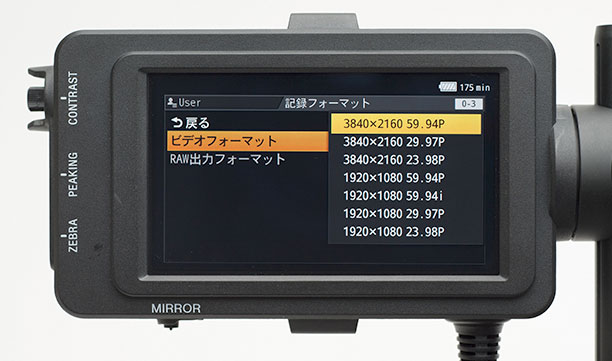
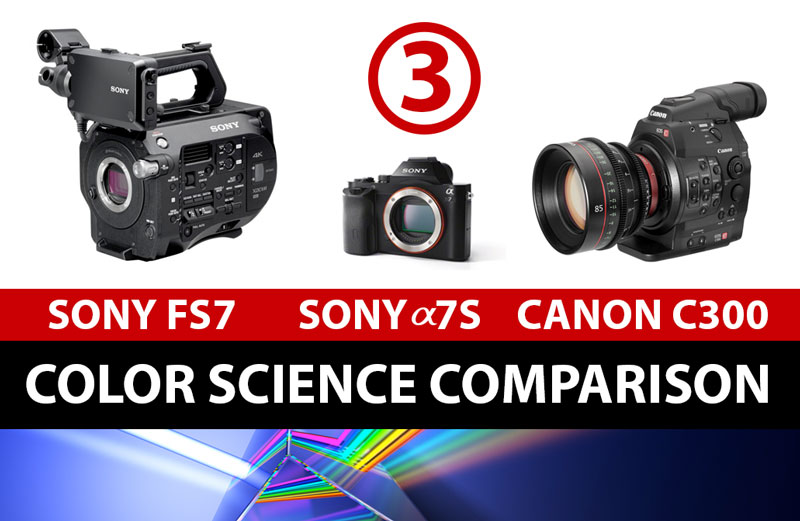
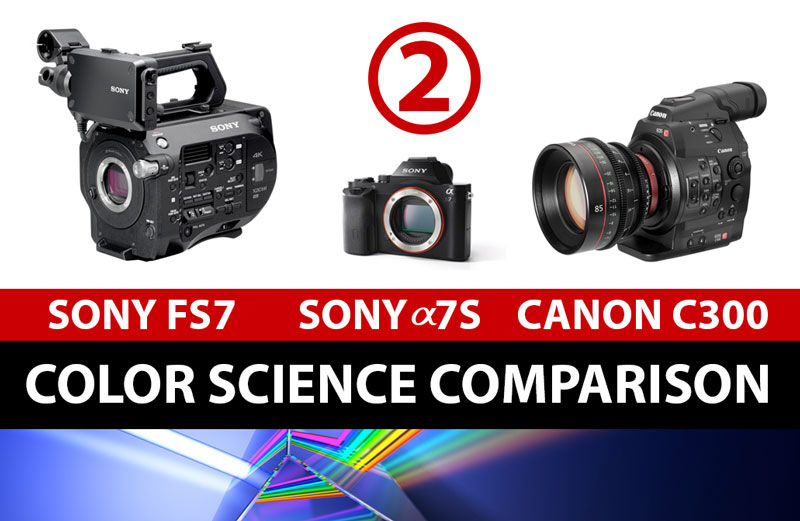
8 Comments
Aaron
25 Nov 2014
Paul
25 Nov 2014
Keyframe
25 Nov 2014
Paul
25 Nov 2014
Side-By-Side Comparison of the Sony FS7, Sony a7S and Canon C300 Footage | 4K Shooters
03 Dic 2014
Sony FS7 4K E-mount test roundup and firmware upgrade. | sonyalpharumors
26 Dic 2014
Steve Jones
26 Dic 2014
Keyframe
26 Dic 2014